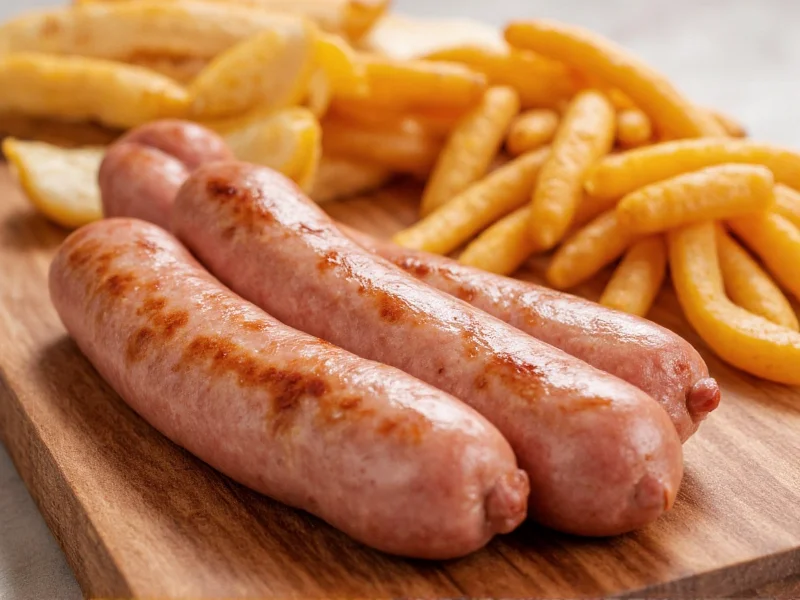Understanding Breakfast Sausage Quality Factors
When evaluating the best breakfast sausage options, several key factors determine quality beyond basic taste. The meat-to-fat ratio significantly impacts cooking performance and final texture. Professional chefs recommend maintaining 20-30% fat content for proper moisture retention during cooking. Sausages with excessive fillers (more than 5% breadcrumbs or cereal binders) often become dry and crumbly when fried.
Ingredient transparency matters most for health-conscious consumers. The healthiest breakfast sausage options use uncured pork with natural preservatives like celery juice powder instead of synthetic sodium nitrites. Look for products listing "pork" as the first ingredient rather than "pork broth" or "mechanically separated pork." Premium brands typically avoid artificial flavors, colors, and high-fructose corn syrup commonly found in budget options.
Regional Variations and Traditional Formulations
Breakfast sausage varies significantly by region, each with distinctive characteristics:
| Regional Style | Key Characteristics | Best Applications |
|---|---|---|
| Midwestern | Mild seasoning, higher fat content (25-30%), fine grind | Biscuits and gravy, breakfast casseroles |
| Southern | Bolder sage and black pepper, coarser grind, 20-25% fat | Patty sandwiches, skillet meals |
| New England | Sweet maple notes, medium grind, 22-27% fat | Pancake pairings, brunch menus |
| Modern Artisanal | Heritage breed pork, organic spices, no fillers | Gourmet breakfasts, special occasions |
How to Choose Quality Breakfast Sausage
Reading labels carefully reveals significant quality differences between brands. The best pork breakfast sausage brands list specific cuts like "pork shoulder" rather than generic "pork." Natural casings (when used for links) indicate traditional preparation methods. Avoid products listing "seasoning blend" as this often hides artificial ingredients.
For those seeking healthier breakfast sausage options, look for uncured varieties with less than 400mg sodium per serving and no added sugars. Turkey or chicken breakfast sausages often disappoint due to insufficient fat content, but high-quality versions compensate with added olive oil and robust seasoning.
Professional Cooking Techniques
Proper cooking technique maximizes flavor regardless of sausage quality. Always start with cold sausage patties in a preheated skillet (medium-low heat). This gradual temperature change ensures even cooking without burning the exterior. Never pierce sausage during cooking, as this releases precious juices. For the best breakfast sausage for biscuits and gravy, crumble the sausage while cooking to create more surface area for browning, which develops richer flavor compounds essential for gravy base.
Homemade breakfast sausage recipe enthusiasts achieve superior results by chilling the meat mixture for 24 hours before grinding, allowing flavors to meld. The ideal ratio for DIY sausage is 3 parts pork shoulder to 1 part pork belly, with 2% salt, 1% black pepper, 0.5% dried sage, and 0.25% rubbed sage by weight.
Objective Product Comparison
When comparing commercial options, focus on ingredient quality rather than brand popularity. Several supermarket brands now offer organic, humanely raised pork options with clean labels. Specialty butcher shops often provide superior texture through proper grinding techniques and fresh spice blends. Frozen sausage patties typically contain more preservatives but can be acceptable if labeled "no artificial ingredients."
For those following specific dietary needs, several brands now offer breakfast sausage without common allergens like gluten or soy. The most versatile options work well both as standalone patties and crumbled for recipes requiring the best breakfast sausage for biscuits and gravy.
What's the difference between breakfast sausage and regular sausage?
Breakfast sausage features distinctive seasoning with sage, thyme, and black pepper, typically in a crumbled or patty form. Regular sausage (like Italian or bratwurst) uses different spice profiles and often comes in casings. Breakfast varieties maintain higher fat content (20-30%) specifically optimized for pan-frying, while many regular sausages are designed for grilling or boiling.
How can I tell if breakfast sausage has gone bad?
Fresh breakfast sausage should have a pinkish color with visible fat marbling. Discard if you notice grayish discoloration, slimy texture, or sour/putrid odor. Properly stored raw sausage lasts 1-2 days in the refrigerator or 1-2 months frozen. Cooked sausage remains safe for 3-4 days refrigerated. Always follow "use by" dates on packaging.
What's the healthiest way to cook breakfast sausage?
Baking breakfast sausage in the oven at 375°F (190°C) on a wire rack allows excess fat to drip away, reducing overall fat content by 15-20% compared to pan-frying. Air frying provides similar benefits with less oil absorption. Avoid burning sausage, as charred meat produces potentially harmful compounds. Drain cooked sausage on paper towels to remove additional surface fat.
Can I make breakfast sausage without sage?
Yes, though sage defines traditional breakfast sausage flavor. Substitute with marjoram, savory, or a blend of thyme and rosemary for similar earthy notes. Some regional variations like New England-style incorporate maple instead of prominent sage. For those with sage allergies, fennel seeds with a touch of nutmeg creates a distinctive alternative profile that still complements morning meals.
Why does my breakfast sausage stick to the pan?
Sausage sticks when the pan isn't properly preheated or when moisture from the meat causes steaming instead of searing. Use a well-seasoned cast iron or quality non-stick skillet preheated to medium-low. Pat sausage patties dry before cooking and avoid overcrowding the pan. Let sausage cook undisturbed for 3-4 minutes to develop a crust before flipping. Proper fat rendering creates its own non-stick surface as cooking progresses.











 浙公网安备
33010002000092号
浙公网安备
33010002000092号 浙B2-20120091-4
浙B2-20120091-4